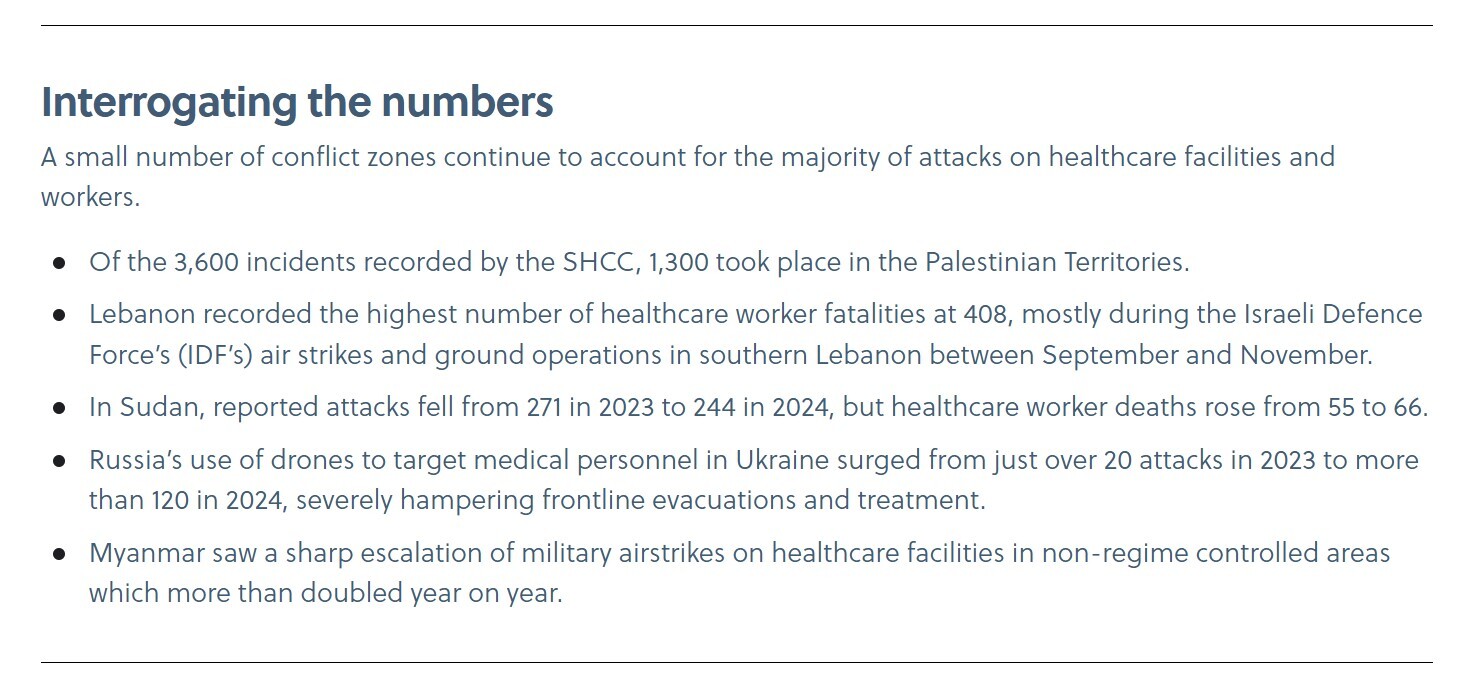No safe passage: the growing threats facing aid workers
The provision of aid in conflict zones has always been a hazardous job, but conditions are becoming increasingly perilous. According to the Safeguarding Health in Conflict Coalition (SHCC), attacks on health workers and medical facilities surged to a record 3,600 incidents in 2024 – a 15 percent increase from 2023. While these figures pertain to healthcare workers, similar risks confront other aid staff in conflict zones and reflect a wider set of challenges facing the sector, driven by declining respect for international humanitarian law, the growing weaponisation of aid, and shrinking funding. With perpetrators rarely held accountable, the frequency and scale of such incidents are likely to grow over the coming year.

State hostility and growing impunity
One of the most troubling trends reflected in recent statistics is the sharp rise in attacks on healthcare workers and facilities by state actors, with nearly 3,000 such incidents recorded in 2024 – almost double the figure from 2023. While international humanitarian law has long served as a cornerstone for protecting aid and medical personnel in conflict zones, that foundation is eroding. Legal organisations have reported a growing disregard for international standards, particularly among government forces, and despite repeated international condemnation – including from the UN – these violations have yet to result in meaningful consequences. This lack of accountability sets a dangerous precedent, as perpetrators become increasingly emboldened in the absence of repercussions. Compounding this is a deepening mistrust of international organisations and multilateral institutions tasked with delivering aid. As a result, instead of being regarded as neutral actors, aid workers are increasingly viewed as extensions of foreign influence or even as parties to the conflict.
The weaponisation of aid
The effective weaponisation of aid and healthcare presents another serious hazard to workers, with warring parties often prioritising access for populations sympathetic to their cause – or, in some cases, deliberately denying aid as a tactic against their rivals. In Sudan, both the Sudanese Armed Forces (SAF) and the Rapid Support Forces (RSF) have employed starvation as a weapon to weaken and demoralise civilian populations, particularly in contested or besieged areas. The RSF has also shut down healthcare centres run by organisations such as Médecins Sans Frontières (MSF) in Darfur, allegedly for treating their rivals instead of RSF combatants. Similarly, in Myanmar, members of the Chinese Red Cross have reported coming under fire from junta forces, which have only allowed aid access to areas deemed loyal to the regime. As a result, humanitarian workers increasingly face the challenge of navigating active conflict dynamics while avoiding any perception of favouritism.
As a result, instead of being regarded as neutral actors, aid workers are increasingly viewed as extensions of foreign influence or even as parties to the conflict.
Less funding, greater peril
Furthermore, as international aid funding comes under growing pressure and conflicts intensify, humanitarian organisations are increasingly forced to do more with less. In addition to limiting the delivery of aid, reduced funding also means less investment in critical security measures such as staff training, risk mitigation, and protection teams – making it harder to adapt to shifting conflict dynamics or maintain safe supply routes. The burden of these gaps often falls on local staff, who already face the highest risks and account for the vast majority of healthcare worker deaths reported by the SHCC. As international organisations rely more heavily on local partners with established networks, these individuals are increasingly exposed – often without the same protections as international personnel and, in some cases, perceived as aligned with opposing factions, as seen in South Sudan where national staff have been targeted in so-called “revenge killings” by militias.
Looking ahead
Adherence to international standards, the ending of impunity, bolstering the capacity of aid organisations from the global to local level are among the many key recommendations from voices within the sector as fundamental to restoring a safer environment for humanitarian workers. Yet, amid intensifying conflicts, the broader erosion of international norms, growing suspicion by states toward organisational agendas, and declining donor funding all suggest that the alarming trend highlighted in the recent SRCC statistics is unlikely to reverse any time soon, and that these recommendations will remain out of reach for the foreseeable future.
